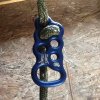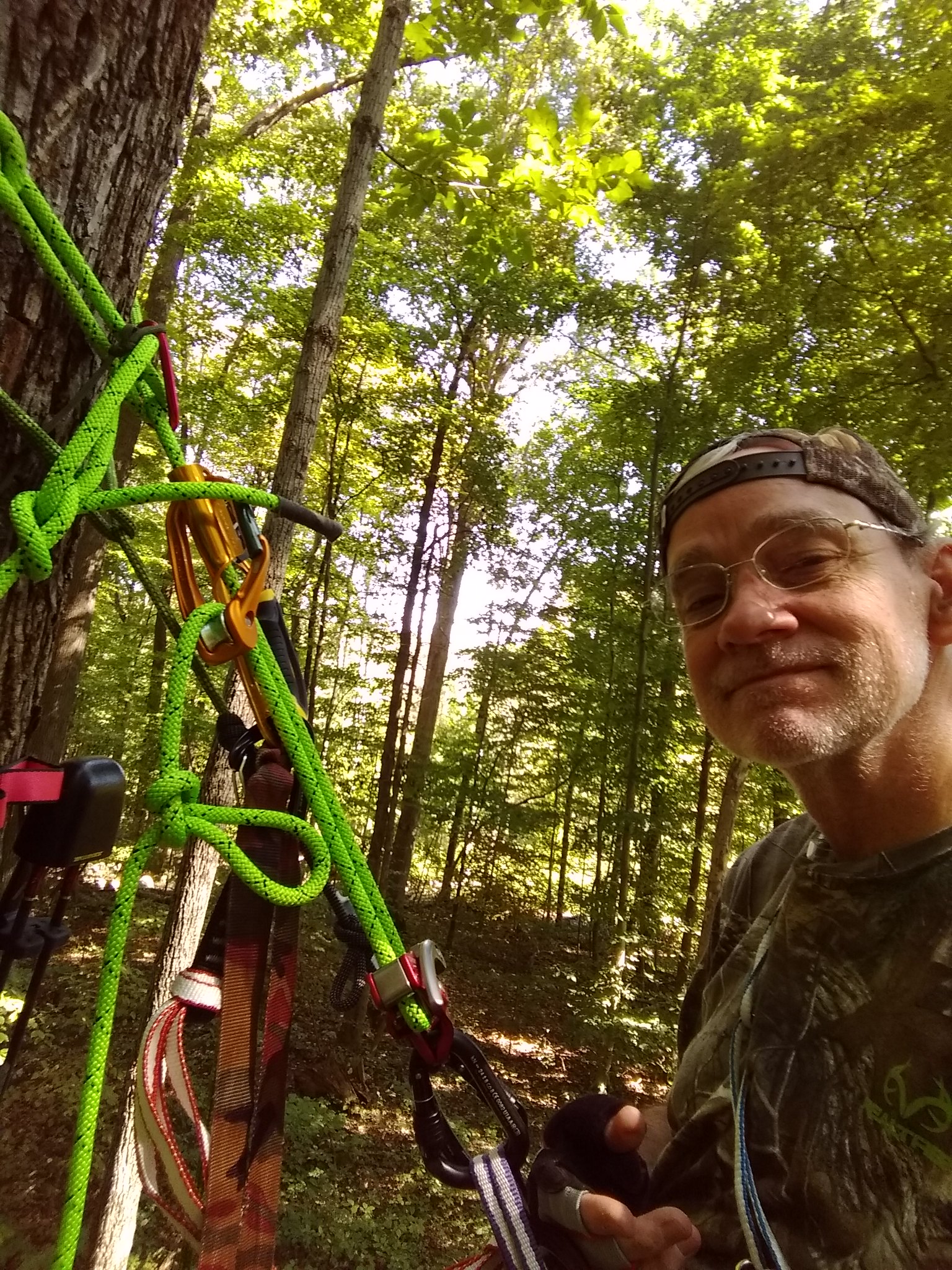Boog
Member
After reading the thread on "The dangers of short, static falls," I started looking into energy absorbers (ripstops an screamers). Along the way I ran across the Kong KISA, an energy absorber that works by friction on the rope rather than threads pulling apart. I decided to give one a try. Here's what it looks like:

The more holes you thread the rope through, the greater the force it takes to make the rope slide. It's designed for use with 11 and 9 mm ropes. I tried it out at ground level with a tether made of Samson Predator and a RC harness and found that with the rope threaded through three holes it didn't slip under my full weight (215 lbs.) even when maneuvering around the tree or if I bounced up and down slightly.
Then I tried to imitate a short fall by standing on a five gallon bucket and jumping off. The rope slid about 6 inches through the KISA and cushioned the fall nicely. I'm 58, and it didn't bother me at all. I repeated the five gallon bucket test several more times with the same result - about 6 inches of rope passed through the KISA before it stopped my fall.
Feeling confident, I decided to try to imitate a fall with the amount of slack I would have during a one-stick climb. (I use the "Cain Method" just like in the video.) As I climb, I make sure to keep my tether attachment point (where it wraps around the tree) at or above my belly button. This introduces around two feet of slack into my tether. To imitate this, I stood on top of a 55 gallon drum with my tether at belly button level and jumped off.

This time, the rope slid 14 inches through the KISA before it stopped my fall. The fall was not uncomfortable. In fact, I tried it a couple more times with the same result. (The white mark on the tether is where the top of the KISA was before I jumped.) Best I could tell, the rope was not damaged or burnt by the friction. (Don't worry, it's an old tether I only use for messing around at ground level, so I won't be using it at hunting height.)
This video shows a little more rigorous testing of the KISA. It's in Russian (I think), so I have no idea what the men are saying. The drop test begins around the 1 minute mark in the video.
THINGS I LIKE ABOUT THE KISA:
1. Replaces friction hitch
2. Shorter than my friction hitch (distel with 24" Beeline eye-&-eye)
3. Way shorter than a screamer attached to a friction hitch
4. Reusable (Screamers are "one and done.")
THINGS I DON'T LIKE:
1. No one-hand adjustment (Though not impossible, it is difficult to move the KISA once you weight it. With a prusik tender, my distel hitch was easy to adjust with one hand.)
2. Metal on metal attachment (The carabiner attaches to the large hole at the bottom of the KISA. I think the noise it makes can be fixed with tape.)

The more holes you thread the rope through, the greater the force it takes to make the rope slide. It's designed for use with 11 and 9 mm ropes. I tried it out at ground level with a tether made of Samson Predator and a RC harness and found that with the rope threaded through three holes it didn't slip under my full weight (215 lbs.) even when maneuvering around the tree or if I bounced up and down slightly.
Then I tried to imitate a short fall by standing on a five gallon bucket and jumping off. The rope slid about 6 inches through the KISA and cushioned the fall nicely. I'm 58, and it didn't bother me at all. I repeated the five gallon bucket test several more times with the same result - about 6 inches of rope passed through the KISA before it stopped my fall.
Feeling confident, I decided to try to imitate a fall with the amount of slack I would have during a one-stick climb. (I use the "Cain Method" just like in the video.) As I climb, I make sure to keep my tether attachment point (where it wraps around the tree) at or above my belly button. This introduces around two feet of slack into my tether. To imitate this, I stood on top of a 55 gallon drum with my tether at belly button level and jumped off.

This time, the rope slid 14 inches through the KISA before it stopped my fall. The fall was not uncomfortable. In fact, I tried it a couple more times with the same result. (The white mark on the tether is where the top of the KISA was before I jumped.) Best I could tell, the rope was not damaged or burnt by the friction. (Don't worry, it's an old tether I only use for messing around at ground level, so I won't be using it at hunting height.)
This video shows a little more rigorous testing of the KISA. It's in Russian (I think), so I have no idea what the men are saying. The drop test begins around the 1 minute mark in the video.
THINGS I LIKE ABOUT THE KISA:
1. Replaces friction hitch
2. Shorter than my friction hitch (distel with 24" Beeline eye-&-eye)
3. Way shorter than a screamer attached to a friction hitch
4. Reusable (Screamers are "one and done.")
THINGS I DON'T LIKE:
1. No one-hand adjustment (Though not impossible, it is difficult to move the KISA once you weight it. With a prusik tender, my distel hitch was easy to adjust with one hand.)
2. Metal on metal attachment (The carabiner attaches to the large hole at the bottom of the KISA. I think the noise it makes can be fixed with tape.)





